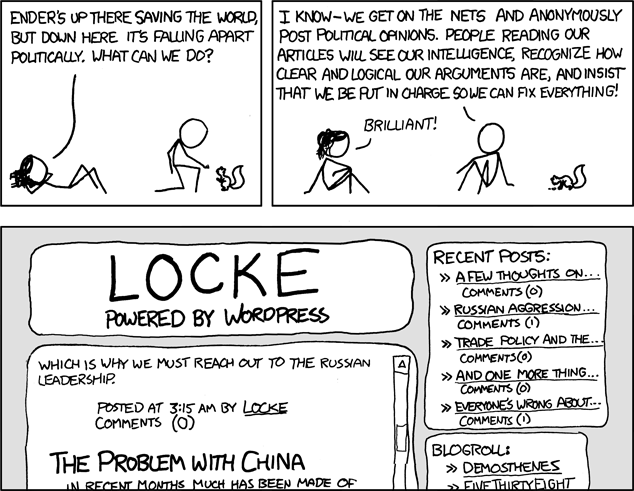A Change of Space
When I write a Worlds of Design column about worldbuilding I usually think in terms of fantasy rather than science fiction. Today I have a sci-fi topic, how “space navies” are likely to work.In this discussion I assume a sci-fi setting is the default. This is not as “locked in” as the default fantasy setting (Spelljammer comes to mind), so there are lots of sci-fi situations where something would change the circumstances. (See Is There a Default Sci-Fi Setting?)
As a reminder, I favor believability in my tabletop role-playing games, much as many people do when they read a novel. The “rule of cool” is rarely applied in my games (that is, “if it’s cool, use it”). How you play your games is up to you, of course.
Nuke it From Orbit, the Only Way to be Sure
Land-based forces are sitting ducks. When the enemy fleet has control of your local solar system space, in most science fiction milieux, the defenders of the system are doomed. Simply put, there’s rarely a good reason to put large numbers of troops on a planet, thereby putting them in harms way and causing significant loss of life on both sides.This point of view is antithetical to many fiction writers. Think of how many science-fiction stories, especially military science fiction, are about ground forces fighting on planets in the distant future. Frequently, it doesn’t matter that it doesn’t make sense; the authors do it anyway in order to provide personal stories of heroism and cleverness. But that doesn’t make it believable.
Non-mobile orbital defenses suffer similarly; they can be crushed by kinetic energy attacks. It doesn't matter how big your “orbital fort” is, even the size of a Death Star, if it can’t maneuver smartly, then it’s going to be destroyed by a competent enemy fleet without much risk to themselves. If you imagine what it would be like on earth to be bombarded by a bunch of (aimed and accelerated) small asteroids or comets, you get the general idea here.
One reason large land/planet-based Armed Forces might make sense is when the attackers are unwilling to “burn off” the planet, or at least to subject it to very damaging bombardment. Whether that burning off is from nuclear weapons or, more practically, from the kinetic energy of large high-speed objects propelled toward the planet, does not matter significantly, because there is no practical defense. So if it’s humans against aliens who don’t care whether we die, ground defenses don’t make sense.
If the attackers are unwilling to bombard a planet, then it will be necessary for attacker ground forces to invade, and defending ground-based forces make some sense. Though without control of outer space, they’d be like WW II forces whose opponents have air supremacy, not merely superiority.
Star Wars Lied
The second antithetical assertion to make about sci-fi combat is that starfighters are unnecessary. They exist because “World War II in outer space” is much easier to relate to than the much more realistic and terrifying world of combat in a zero-gravity vacuum.For movies like Star Wars, starfighters make it easy for the audience to focus on a specific pilots in the chaotic mess of combat, complete with “guns” and dogfighting. (But often without wingmen!) Yet dogfighting went out of fashion during WW II (in favor of boom and zoom), and the original F4 Phantoms of the Vietnam War days had no guns because designers (prematurely) thought that all air fighting would be done with long range missiles. More than 50 years later, it’s mostly all missiles.
Functionally, there is rarely a place for fighters in space combat. How do they damage the big ships without destroying themselves? Why don’t you just use unmanned, possibly autonomous, missiles fired from large ships, not manned fighters, that can crash into their targets? And if there are fighters in space, they will certainly not look like jets. With no air in outer space, and large ships unlikely to descend into atmosphere, the most efficient ship shape is a roughshod sphere. But spheres rarely look cool. Star Wars streamlining especially doesn’t make sense, as warships can slowly float anywhere in atmosphere, and won’t meet much of the atmospheric resistance that requires streamlined hulls.
And carriers? In the real world, aircraft carriers were distinct from other vessels because a full flight deck was required. This won’t be true in airless, weightless outer space. So even if starfighters are somehow functional, any sufficiently large ship will be able to carry some, and no ship needs to be entirely devoted to fighters.
In function, there is no analogy to air(plane) power in outer space. Airplanes (in WW II and today) are much cheaper than large ships, much faster, but of limited duration before they need to return to a base. Yet they can destroy an enormous ship with bombs, torpedoes, missiles. In the modern world we have air, sea, and land power. In space we only have land power and space power (equivalent to sea power, but more, well, powerful).
The ongoing sci-fi series Ascent to Empire by David Weber and Richard Fox presents a possible justification for carriers, though not fighter carriers per se. Interstellar drives require a 450 meter wide “fan.” So interstellar ships are very large and expensive. This means starships are limited to a few merchants and liners, and to faster-than-light carriers (perhaps as fabulously expensive as fleet carriers today except there are a lot more planets to pay to build them). The carriers are heavily armed and armored, but also carry large warships attached and launched in solar system space (no interstellar drives, making them more efficient weapons platforms).
Space Is BIG
Space is big. Really big. “Guns” are unlikely to be used instead of missiles, though that’s heavily technology dependent. (“Guns” as in anything where the “projectile” is not self-propelled and probably not self-guided.)In WW II, offensive weapons at sea were projectiles from guns, bombs dropped by planes, and torpedoes. The analogy for the latter two in space is missiles, likely guided missiles since an unguided missile is as likely to miss as a projectile. Missiles can be as large as the largest object a warship can carry.
In space, anything that cannot change direction during travel is likely to miss by many miles as its target maneuvers. Even fast-as-light lasers (or “blasters”) take time to get to a target at spatial distances (e.g. one-and-a-third seconds for moonlight to reach the nearby earth, eight-and-a-third minutes from the sun to earth). Air-to-air missiles today can fly more than a hundred miles, and it will be far more where gravity is absent as missiles can coast without expending fuel.
Similarly, detection of incoming enemy ships is likely to be very short-ranged, in spatial terms, like near the outer planetary orbit of a star system, or less. That’s still enormous coverage. This makes defense of your systems problematic. If you don’t know where the enemy is, even vaguely, how can you place your mobile defenses? At worst, one large enemy force can bounce around among your systems and you won’t be able to defend any of them sufficiently.
Space is BIG and defenders do well to plan accordingly – less trying to “patrol space” and more trying to defend planets by keeping their bases close to home. We'll pick up this discussion with three more ways a realistic space navy would operate in the next article.
Your Turn: Do you prefer “WW II in space" or more realistic combat for your sci-fi campaigns?





